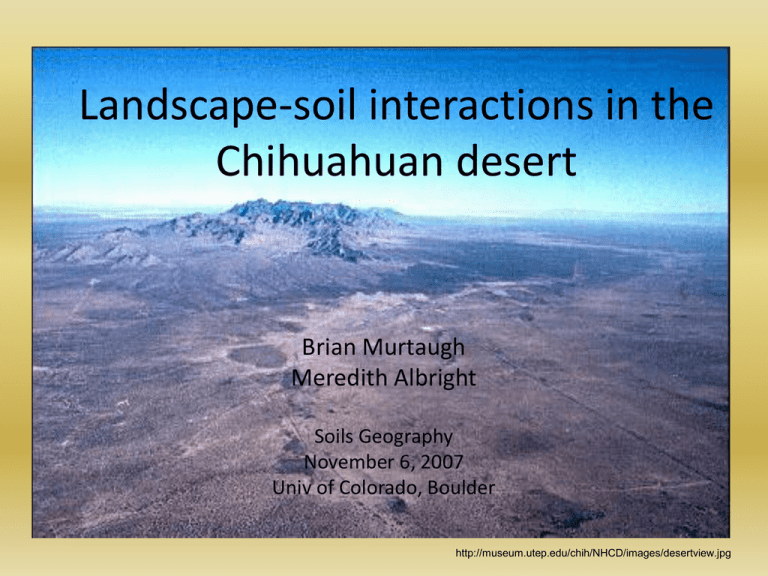
Landscape-soil interactions in the
Chihuahuan desert
Brian Murtaugh
Meredith Albright
Soils Geography
November 6, 2007
Univ of Colorado, Boulder
http://museum.utep.edu/chih/NHCD/images/desertview.jpg
Introduction
• Located in Chihuahuan Desert
• 60 km apart
• Sevilleta
–
–
–
–
250 mm annual precipitation
Moisture deficit most of the year
Low 1.6° C
High 25.1° C
• Jornada
– 250 mm annual precipitation
– Low 5° C
– High 25° C
SEV
Desertification and Soil
Jornada Basin
New Mexico, USA
Site
Desertification
5 Major Ecosystem Types
• Grasslands
– Black grama
– Playa
• Shrublands
– Creosotebush
– Honey mesquite
– Tarbush
Grasslands
• Little bare soil
• Even soil dispersal
• Being overtaken
Black grama grasslands
•
•
•
•
Sandy/gravely sites
Deep loam
CaCO3
Relatively higher moisture
content
Playa grasslands
• Low-lying
• Clayey soils
• Consistent
texture
Tobosa
Burrograss
Shrublands
• Vegetation spread out
• Nutrient islands
• Slowly take over grasses
Creosotebush
• Locations vary
• Soils vary
• Little difference in
soil moisture
• Produce compounds
that influence other
growth
Honey mesquite
• Deciduous shrubs
• Deep roots
• Most soil types
Tarbush shrublands
• Deciduous
• Clay-loam soils
• Might receive run-in
water
• Use deeper water
Climate and Soil
• Soil profiles hold evidence of past
• Clay mineralogy
• Carbonates
Carbonates
•
•
•
•
•
Illuvial
Tell age of horizon
Grasses -> C4
Shrubs -> C3
C4 dominates
Future Research
• Soil moisture content, texture, vegetation type
• Ecosystem dynamics
Takehome from Jornada
•
•
•
•
Grasslands overrun by shrublands
Carbonates tell history of region
Low variance of soil types
Soil moisture changes throughout site
Sevilleta National Wildlife Refuge
• 80 km south of Albuquerque
• Importance of site
– Ecotones
– Focus: Chihuahuan desert grassland
to shrubland
Google Earth
http://sev.lternet.edu
Grama-dominated grassland
• Invasion of creosotebush
(Larrea tridentata) into grasslands
– Potential causes: climate change, increased
rodent activity, altered fire frequency, landuse changes, shift in groundwater levels
– Changes in species composition
– Changes in surface soil
How do soils change with the transition
from grasslands to shrublands?
http://sev.lternet.edu/
Creosotebush
– Soil profile
– Texture
– Nutrients
http://sev.lternet.edu/
Distribution of Vegetation
Grassland
• Grassland to shrubland
– Decreased biomass
– Decreased soil coverage
• Affects soil characteristics
Shrubland
– Soil profile
– Texture
– Nutrient levels
(Cross and Schlesinger, 1999)
Soil Profile
Grassland
• Grassland
– Argillic horizon over a CaCO3
horizon
• Shrubland
– Patchy erosion of argillic
horizon
• Under shrubs - relics
• Between shrubs –exposure of
CaCO3
Inhibits grass
establishment
Shrubland
• Positive Feedback
(Kieft et al., 1998)
Nutrients
• Essential nutrients (N, K,
organic C)
– More highly concentrated
under shrubs
– Microbial microsites
(greater moisture and OM)
• Positive feedback
Increased
nutrient cycling
(Kieft et al., 1998)
Texture
• Soil Texture
– Grassland
• uniform texture
• 83% sand, 8% silt, 9% clay
– Shrubland
• Heterogeneous
• 64% sand , 26% silt, 10% clay
• Consequences
– Under shrubs
• Higher water holding capacity
• Increased CEC
• Positive feedback
Deposition of
fine particles
(Kieft et al., 1998)
Conclusions
• Positive feedback towards shrublands
– Patchy distribution of fine-textured soils
– Loss of the argillic layer between shrubs
– Patchy distribution of essential nutrients
• Shrubland encroachment is widespread
– Creation of islands of fertility in Sevilleta and Jornada
• Characteristic soil qualities under grasses vs. shrublands in
both sites
http://www.nsf.gov/news/mmg/media/images/eco4_f.jpg
References - Sevilleta
•
•
•
•
•
•
•
•
Kieft, T.L., C.S. White, S.R. Loftin, R. Aguilar, J.A. Craig, D.A. Skaar. 1998. Temporal Dynamics
in soil carbon and nitrogen resources at a grassland-shrubland ecotone. Ecology 79(2): 671683.
Cross, A.F., W.H. Schlesinger. 1999. Plant regulation of soil nutrient distribution in the
northern Chihuahuan Desert. Plant Ecology 145: 11-25.
White, C.S., D.I. Moore, J.A. Craig. 2004. Regional-scale drought increases potential soil
fertility in semi-arid grasslands. Biology and Fertility of Soils 40: 73-78.
Schlesinger, W.H., J.A. Raikes, A.E. Hartley, A.F. Cross. 1996. On the spatial pattern of soil
nutrients in desert ecosystems. Ecology 77: 364-374.
Kurc, S.A., E.E. Small. 2007. Soil moisture variations and ecosystem-scale fluxes of water and
carbon in semiarid grassland and shrubland. Water resources research 43: 1-13.
Long Term Ecological Research, Sevilleta. http://sev.lternet.edu/
Brady, N.C., R.R. Weil. The Nature and Properties of Soils. Pearson Prentice Hall, 2008.
Buxbaum, C.A.Z., K. Vanderbuilt. 2007. Soil Heterogeneity and the distribution of desert and
steppe plant species across a desert-grassland ecotone. Journal of Arid Environment 69: 617632.
References - Jornada
•
Havstad, Kris M., L.F. Huenneke, William H. Schlesinger (Eds.), Debra P.C. Peters,
Robert P. Gibbens, Structure and Function of a Chihuahuan
Desert
Ecosystem: The Jornada Basin Long-Term Ecological
Research Site,Oxford
University Press 2006







